7 Valuable Baseball Cards You May Own (And Not Even Know It)
People call me all the time wanting to sell their baseball card collections. Many of them think they can retire by selling off the card sets manufactured and purchased after 1980. The reasoning is that some of those cards are now pushing 35 years old and age adds value, right? Well, they are unfortunately wrong.
Those years were smack dab in the middle of the collecting frenzy, particularly in the span of 1984 to 1994. People bought sets by the millions and the card manufacturers were more than willing to accommodate them by overprinting even for that strong demand. As a result, there is very little from that era that is worth more than kindling for the fireplace. But there are some gems hidden in the modern era cards issued from 1980 onward.
These are not special cards like autographs, relics, chrome refractors or one-of-one printings. They are just normal, everyday cards that you may own if you are an average collector. They are cards that, for the most part, are what you would have pulled out of a regular pack of baseball cards or found in a factory set that you purchased at a card shop or retail store.
Here are seven to hunt for in chronological order.
1982 Topps Traded, card #98T - Cal Ripken, Jr
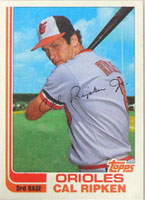 This was his rookie card and was included in the regular 132 card traded set. It came in a small box with the rest of the set and is relatively non-descript. This card in near mint/mint condition is worth between $100 and $140 If you should have one in perfect condition, you may get upwards of $5,000 for it. As an added bonus, the 1982 Topps Traded set also included the Ozzie Smith (card #109T) that sells for about $20.
This was his rookie card and was included in the regular 132 card traded set. It came in a small box with the rest of the set and is relatively non-descript. This card in near mint/mint condition is worth between $100 and $140 If you should have one in perfect condition, you may get upwards of $5,000 for it. As an added bonus, the 1982 Topps Traded set also included the Ozzie Smith (card #109T) that sells for about $20.
1986 Topps Traded Tiffany, card #11T - Barry Bonds
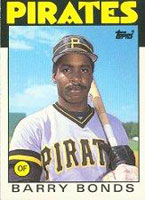 Another rookie card offering, but with a twist. Topps offered two versions of the 1986 Traded set: the regular version in the normal box and the Tiffany version which was packaged in a nice box. The cards themselves were also different. The Tiffany's were printed with a much brighter finish and high gloss fronts. They were also very limited in number; they printed only 5,000 sets. The Bonds card out of the box is worth between $75 and $100, but if you can get one that will grade at a 10, it may be worth up to $1,000 or more at auction.
Another rookie card offering, but with a twist. Topps offered two versions of the 1986 Traded set: the regular version in the normal box and the Tiffany version which was packaged in a nice box. The cards themselves were also different. The Tiffany's were printed with a much brighter finish and high gloss fronts. They were also very limited in number; they printed only 5,000 sets. The Bonds card out of the box is worth between $75 and $100, but if you can get one that will grade at a 10, it may be worth up to $1,000 or more at auction.
1989 Fleer, card #616 - Bill Ripken
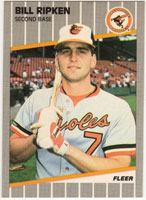 OK, so someone in the Orioles organization had a bizarre sense of humor and someone at Fleer was not paying attention to their job. It appears that some prankster took at black marker and wrote the "F" Bomb on the bat handle Ripken was holding in the photograph used for the card. It is as clear as day. A lot of them got through before anyone noticed and, as such, as worth about $8. But then they tried to correct the card without retaking the picture. Fleer made four different attempts. One showed a black scribble. Another showed a black box over the bat handle. A third just printed a blank strip at the bottom of the card. Those are all over the place and not worth much. But one genius decided to use White Out and cover the "F" Bomb. Those are rare and show a white blotch where the bat knob is located. They were placed in the early printing packs and are worth between $250 and $750.
OK, so someone in the Orioles organization had a bizarre sense of humor and someone at Fleer was not paying attention to their job. It appears that some prankster took at black marker and wrote the "F" Bomb on the bat handle Ripken was holding in the photograph used for the card. It is as clear as day. A lot of them got through before anyone noticed and, as such, as worth about $8. But then they tried to correct the card without retaking the picture. Fleer made four different attempts. One showed a black scribble. Another showed a black box over the bat handle. A third just printed a blank strip at the bottom of the card. Those are all over the place and not worth much. But one genius decided to use White Out and cover the "F" Bomb. Those are rare and show a white blotch where the bat knob is located. They were placed in the early printing packs and are worth between $250 and $750.
1990 Topps, card #414 - Frank Thomas
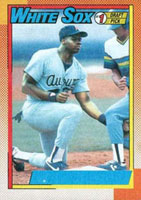 There is nothing special about this card even though it is his rookie card. It is worth about $2, if that. But if you find one where they neglected to print his name on the front, you have a card worth between $700 and $1,000. Graded at Mint? Who knows? I can assure you that it will sell for a whole lot more than $1,000, though.
There is nothing special about this card even though it is his rookie card. It is worth about $2, if that. But if you find one where they neglected to print his name on the front, you have a card worth between $700 and $1,000. Graded at Mint? Who knows? I can assure you that it will sell for a whole lot more than $1,000, though.
1993 Topps, card #98 - Derek Jeter
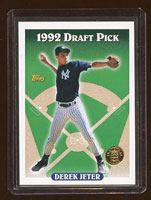 This is his rookie card. It was contained in the regular issue factory sets and in packs. It is worth about $30. But, if you happened to pick up one of the special factory sets Topps made to inaugurate the first year of play for the Florida Marlins or Colorado Rockies it is currently worth between $100 and $150. These sets were limited to 10,000 copies and had a special embossed logo on the front of the cards. As Jeter gets closer to retirement and entering the Hall of Fame, these cards are destined to rise in value.
This is his rookie card. It was contained in the regular issue factory sets and in packs. It is worth about $30. But, if you happened to pick up one of the special factory sets Topps made to inaugurate the first year of play for the Florida Marlins or Colorado Rockies it is currently worth between $100 and $150. These sets were limited to 10,000 copies and had a special embossed logo on the front of the cards. As Jeter gets closer to retirement and entering the Hall of Fame, these cards are destined to rise in value.
1999 Topps, card #220 - Mark McGwire
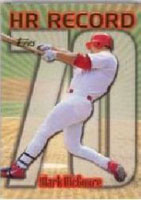 This is an odd card. Topps printed 70 different variations, one for each home run McGwire hit in the previous year. The different cards were randomly seeded in packs. It was the luck of the draw as to which one you would get. Most of them are worth about $15 except the one representing home run number 70. That sells for about $100 to $125. A cards graded at pristine mint would sell for a whole lot more, but one has never surfaced.
This is an odd card. Topps printed 70 different variations, one for each home run McGwire hit in the previous year. The different cards were randomly seeded in packs. It was the luck of the draw as to which one you would get. Most of them are worth about $15 except the one representing home run number 70. That sells for about $100 to $125. A cards graded at pristine mint would sell for a whole lot more, but one has never surfaced.
2010 Topps, card #661 - Stephen Strasburg
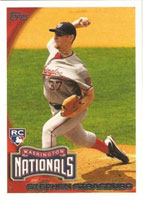 Well, what would you expect for the card of someone who has the potential of being the greatest pitcher ever in the game of baseball? His rookie card garnered a huge amount of pricing speculation, then dropped off after he missed a year due to Tommy John surgery. But now that he is back and stronger than ever, the card price is going back up. But which card? There are at least nine different variations of his "rookie" card, six of them printed and included in the Topps factory sets and packs while the others were special printings for companies like Target and Wal-Mart (plus one with him being hit in the face with a pie.) Right now the most valuable one at $150 is #661E where he is wearing a grey jersey. In 20 years if he shatters records and is inducted into the hall of fame, who knows? Collect them all and hang on to them.
Well, what would you expect for the card of someone who has the potential of being the greatest pitcher ever in the game of baseball? His rookie card garnered a huge amount of pricing speculation, then dropped off after he missed a year due to Tommy John surgery. But now that he is back and stronger than ever, the card price is going back up. But which card? There are at least nine different variations of his "rookie" card, six of them printed and included in the Topps factory sets and packs while the others were special printings for companies like Target and Wal-Mart (plus one with him being hit in the face with a pie.) Right now the most valuable one at $150 is #661E where he is wearing a grey jersey. In 20 years if he shatters records and is inducted into the hall of fame, who knows? Collect them all and hang on to them.
Here is something else to consider.
All the major card companies - Topps, Donruss, Score, Fleer, and Upper Deck - issued factory sets my the millions. Most of those sets are functionally worthless even though they all contain at least one card worth a dollar or five. But in the past ten years or so something has developed in the card market: the grading of cards.
Graded cards are those certified to be of a particular quality and are sealed in a plastic slab with the grade number noted on it. The higher the grade, the more valuable the card. As interest in this aspect of the trade grows, more and more people are cracking factory sets to pull out the small handful of cards that could possible grade at a 9.5 or 10, thereby dramatically increasing their value over an ungraded version.
As such, sealed complete factory sets are becoming scarcer over time and will continue to grow in rarity. It may be that 20 years from now a sealed factory set that otherwise today would not even be worth trying to sell might actually be worth some serious money.
Most Popular
The ULTIMATE
Collection
for the
ULTIMATE
Baseball Fan!
- A complete 41 Year collection of your favorite MLB team.
- Every Topps® standard issue card from 1977-2017
- PLUS Topps® Traded cards, cards with multiple players such as League Leaders, World Series and Future Stars, and all of the rookies from the '90, '91 and '92 Topps® Debut sets.
Choose Your Favorite Team For Detail And Become One Of Our Happy Customers:
"I want to personally thank Steve Crisp in all the hard work he puts into putting together such a fine product as well as thank him for bringing back the joy collecting has brought to me. I am a die hard Mets fan who like many other people collected baseball cards as a kid. I collected from the mid 1980's to the early 1990's because I love the game and I am such a huge Mets fan. As I went through my teenage years I grew apart from collecting cards but always had my love for the game and my team. One thing though that I always wanted to do though is put together a complete and comprehensive Mets Baseball Card collection but for over 20 years that dream was put on hold. 2 years ago I saw this page on Facebook and my thoughts of putting together this collection became renewed. So I jumped in, 2 years ago today. I had the pleasure of talking to Steve as well as meeting him when I picked up my Mets Ultimate Team Set from him (We both ironically live in the same town!). I told Steve what I wanted to do for a collection and he was gracious enough to help me out with complete team checklists and he gave the springboard to start my dream collection. In 2 years, I started with nothing, and bought this collection of 1273 cards. They are so well put together and I can't recommend the product enough to anyone who loves baseball and has a favorite team. Well, today my collection has grown to 6665 cards, no duplicates, all Mets. But I would have never got the ball rolling if it wasn't for my initial investment in my Ultimate Team Set. Thanks again to you Steve for all the hard work you put into putting this great product together and thank you for getting me back into this fabulous hobby again. If anyone out there is looking to but together an Ultimate Team Collection this really is the best place to start! Lets Go Mets!"
New York Mets
(03/29/2016)
"If you are on the fence about making this purchase - get off it and buy it!"
New York Mets
(10/28/2015)
"First Class Seller A+"
New York Mets
(10/22/2015)
"Excellent communication, fast ship, incredible product. Many thanks again."
Toronto Blue Jays
(10/12/2015)
"Fast delivery and great product!"
New York Mets
(10/08/2015)
"Fast & Accurate - Recommended"
New York Mets
(10/01/2015)
"Item as described, excellent correspondence, highly recommend, an asset to eBay!"
Detroit Tigers
(08/22/2015)
"Great seller"
Baltimore Orioles
(08/07/2015)
"Once again, excellent deal. very satisfied. repeat customer, HIGHLY recommend!"
Tampa Bay Rays
(08/01/2015)
"5 Star"
St. Louis Cardinals
(06/20/2015)

Comments